I would rate red mites as being one of the biggest problems you will face when keeping chickens. Red Mites live in the cracks of chicken houses (typically under perch ends) coming out at night, crawling onto your birds for a feed.
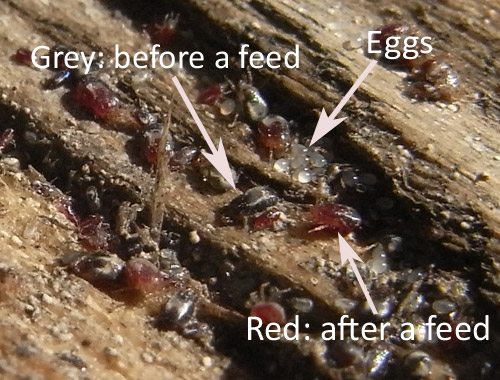
Macro shot of Red Mite in a crack on a perch. These were disturbed after a treatment with Poultry Shield.
They start off as very small greyish-white mites that swell up into red coloured mites after a feed and at their biggest are only 1mm so small numbers of them can be hard to spot unless you know what to look for.
You will often find a grey ash like deposit around perch ends which is where the mites have been and if you lift the perch, you will see clumps of mites.
Red Mite in chickens’ houses are active during the warmer months, usually May to October and will become dormant over the winter. They multiply at an incredible rate: their life cycle is just 7-10 days. In other words from hatching from an egg to being an adult laying hundreds of eggs takes just a week if conditions are right.
Be Proactive.
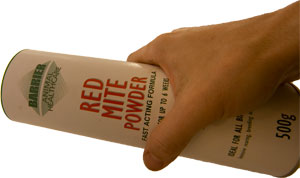 The best course of action is to check for red mite routinely when you clean your chicken house out and use some preventative treatment to the house before they get a hold. You will get to know the places to look and once you have found small numbers of them, you can treat the house to keep numbers under control. See my ‘preventative measures’ below
The best course of action is to check for red mite routinely when you clean your chicken house out and use some preventative treatment to the house before they get a hold. You will get to know the places to look and once you have found small numbers of them, you can treat the house to keep numbers under control. See my ‘preventative measures’ below
Are there Red Mite in your Chicken House?
People normally discover Red Mite when they are over-run by them. When hens are being bitten, they can refuse to go in to roost at night, they will become anaemic and their combs will go pale. They will often stop laying and you may find red blood stains on eggs (squashed Red Mites). Eventually, you will start to see losses in the flock.
Checking for Red Mite in Chickens Houses
Red Mite will hide away in the daytime but can often be seen if you lift perches, examining the ends. They will usually come swarming out if you treat the cracks with Poultry Shield but by far the easiest way to check to see if there are red mite is to take a piece of white kitchen roll and to rub it along the underside of the perch when your hens are roosting (in the dark). Look at the tissue and if there are Red Mite heading back from their feed, they will be squashed on the kitchen roll as streaks of blood.
Getting rid of Red Mite
It is very hard to get rid of them completely so it is often better to get the numbers down and then find a way of keeping them down that doesn’t involve you spending hours on cleaning the house out. There are lots of different treatments that people use, some more effective than others but I will focus on what I do and have found to be the most successful for me.
If you haven’t got red mite and the weather is warm enough for them (May to October in the UK) then skip step 1 and go straight to step 2. Preventative Measures.
1. Getting rid of an infestation.
If you find lots of red mite in the coop, it’s time for a big clean up that will take a couple of hours initially, then an hour every 5 to 7 days for at least 2 more weeks.
The products I have found to work the best (that are relatively safe) are Poultry Shield and Diatom. These two are not ‘knock down’ products as such, they do take a little while to work but are none the less very effective. I also use Red Mite Powder on the hens themselves to help them through the night when the Mites are active.
You can BUY Poultry Shield from Amazon Here.
Here is what I do with the Poultry Shield.
- Remove all birds from the house.
- Strip the house down as much as possible.
- Clean the house out – be careful where the bedding is going as red mite live for 6 months without a feed and will find a new home If they can. Ideally seal the bedding in bin bags or burn.
- Mix up as many watering cans of poultry shield mixture as is needed, as per the instructions on the label 1 part to 9 parts water.
- ‘Water’ all cracks in the chicken house, concentrating where there are perch ends and concentrations of red mite.
- Leave to soak for 15 minutes
- Red mites will be coming out. Cover them and the cracks with poultry shield again.
- Wait 15 minutes
- Hose out the house, concentrating on getting the pressure jet into the cracks and so on.
- Leave the house to dry.
Poultry Shield is a mild detergent and ‘washes’ the waxy coat off the red mites. It is also good for removing organic matter from the hen house so is useful for cleaning. I wouldn’t be without this!
After using the Poultry Shield, when the house is dry, I use Diatom. Diatom is made of micro skeletons of fossilised remains of diatoms. These were once a kind of algae found in water. They are microscopically sharp and pierce the outer waxy coating of the mites which causes them to dry out and die.
The second step also double up as my ‘preventative’ measures if you haven’t yet got a bad infestation
You can BUY Diatom from Amazon HERE
2. Preventative Measures
- Dust the ends of the perches / nest boxes and where ever else you found concentrations of red mites when cleaning.
- Rub as much into the perches as you can. Red mite will avoid the diatom and will crawl around it if they can, so make sure they have to crawl through it to get a feed.
- Repeat every couple of days for as long as you see signs of red mite in the coop.
Repeat the whole cleaning process if there are still lots of mites in 5 to 7 days. You will find you might not need to spend as long on the washing as there won’t be as many mites.
Very Important: Make sure you repeat it before 7 days so that the mites don’t have a chance to lay more eggs. A few mites become a lot in a very short space of time!
If you have a felt roof on your chicken house and they get underneath, it is usually impossible to get rid of them without removing the felt, cleaning and re-felting. My page on Chicken Houses gives more information.
Finally, I will dust the hens down between their feathers with Red Mite Powder to give them some respite during the night when the mites are active.
Beware of what you read!
There is a lot of information written about these troublesome ectoparasites on the internet these days, much of it re-written and re-spun. When I started writing about them, there was little available online. Strangely, some small errors that I had introduced on my page that I corrected in an update pop up frequently on other websites. Running a Google image search often uncovers companies that have used my copyrighted images! I make regular checks to try to stop this from happening.
If you wish to learn more about red mite then I would encourage you to read the guide to red mite on poultrykeeper.com. This is a reliable source of information and is regularly updated.

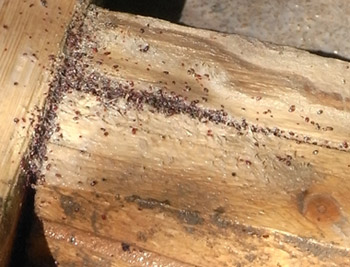

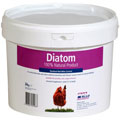

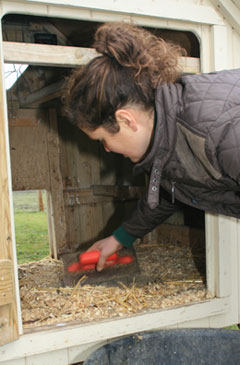
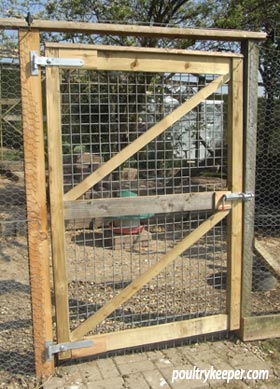
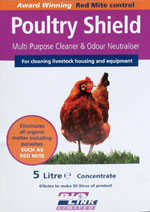
Hi,
we recently got some chickens, apparently treated for red mite, only to discover they were crawling. The hen house is riddled now also. So I’m treating with DE powder and natural insect repellent spray (cedar, citronella and tea tree oil diluted in a spray bottle)
My question is this:
Should I be concerned about them getting indoors on my clothing etc? I have found a few crawling on me after changing the chickens’ bedding etc. If this is going to be a problem, how best to deal with it? TIA
Yes, they do itch don’t they! I’ve never had a problem, I will wash clothes, and shower afterwards.
Rub the diatom into the perches, especially the underside. The mites will have to crawl through it and I find this manages their numbers well.
I have a mite infestation which I’m treating. Next week a new plastic house will arrive. I’ll burn the old wooden one and transfer the birds to their new home. I’m feeding meal worms, adding vitamins to their feed and sprinkling them with powder every 3 days. But a few are looking very poorly. Can you advise on recovery and if my future plans sound sufficient? Thank you.
Ivermectin, (a few drops on the skin) although not licensed for chickens will kill off any mites that stay on your chickens.
For recovery, free range is the ultimate solution. Chickens will self medicate. The trouble with vitamins in food is that you are often overdoing some of them and I think the latest veterinary advice is to leave them out in between so as not to overdo them.
I would try to provide pellets, lots of greens, weeds and grass, they should get a chance to take what they need from this.
Don’t forget if they look scrawny, to make sure they have been wormed.
Hi I have red mite my poor girls it’s the first time I have seen them I have even found them on me yuk I was wonder do you think let off flea bombs in the coop would help while the girls are out roaming all day ???
They might, I haven’t tried these though.
Hi I have three wooden chicken coops and one of them was over run with red spider mites. I didn’t know what was going on at first. every time I got near the coop these things were crawling on me. I washed the coop out three times with poultry shield but still it was infested. then a friend at work told me to buy some creosote, rip the felt off and treat the chickens with Ivermectin. I waiting for the creosote to arrive. I’ve cleaned my other coops with poultry shield and I’ve dusted the chickens and coops with diatom powder. I was finding the things crawling on me every time I went near where the infested coop had been even though I had moved it a way (as that will need burning) The chicken that was in that coop is now in a plastic cat carrier in her pen until I can buy a second hand omlet plastic coop. I was and am very worried and paranoid about the mites getting in the house and every time I feel any movement on my skin I’m looking! I’ve started wearing different clothing when I go out to the chickens. The question I’m trying to find out is if I treat my hens with the Ivermectim is it then safe to eat the eggs? Because it is not a licenced product for chickens I’m having trouble finding this out. My local vet doesn’t know and they are asking another vet for me who might know. Looking on the internet I can see that some people have discovered the product and my friend uses is on her hens. I do feel it is something that will keep these very nasty mites under control but if it is considered unsafe or questionable over eating the eggs even after a period of time then I can not use it. I hope you can shed more light on this for me kind regards Claire
That’s the million dollar question Claire. Testing a product like this costs a huge amount which (I guess) is why it hasn’t been done. Nobody can say for sure. Vets will sometimes prescribe unlicensed products under their clinical judgement and advise on an egg withdrawal period to be safe. I’ve heard of everything from 7 to 28 days for some products – so the truth is vets are just giving some ‘safety margin’ before eating eggs, nobody really knows if the testing hasn’t been done.
I used Ivermectin spot on from time to time in the past and I withdrew eggs for 7 days. This has also been the withdrawal period from a few vets I have heard of prescribing Ivermectin for Lice.
I have to say though – I do not endorse the use of unlicensed products on non-target species and you should always seek the advice of your vet.
I bought a blow torch and after cleaning out my coop I carefully ( you really do need to be careful ) blasted the coop like a flame thrower and burnt the little nasties. It’s great as the heat really gets to all those cracks. Just be careful you don’t set fire to it all by leaving the flame on one spot too long. After that, I clean with poultry sheid and then dust everything with red mite powder and then treat the hens.